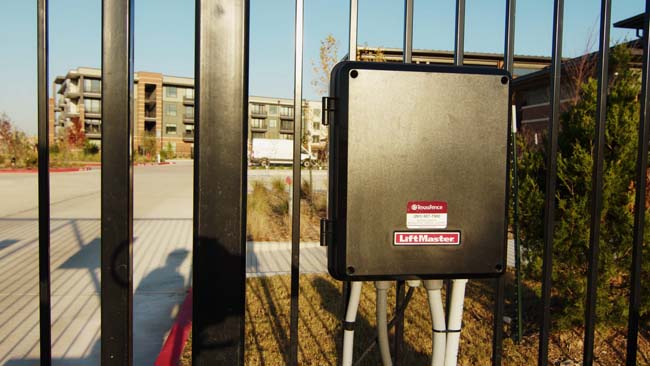Gate Access Control Systems: Enhancing Security and Efficiency
As concerns about security and efficiency continue to rise, home and business owners are increasingly seeking innovative solutions to ensure their properties remain safe and easily accessible. Enter access gate control systems – a game changer in the realm of property protection. These ingenious devices do more than just unlock your gates; they revolutionize the way you manage access to your premises altogether. In this blog, we’ll delve into how these streamlined systems can reinforce security while boosting efficiency, keeping your Texas property secure day and night. Stick around to unpack the key features of access gate control systems, their benefits, and why it’s high time you considered implementing one on your property. So, let’s open the gates to heightened security and unparalleled convenience!

Understanding Gate Access Control Systems
Gate access control systems play a vital role in enhancing security and efficiency in various settings, including residential neighborhoods, commercial complexes, and gated communities. These gate access control systems are designed to regulate access to specific areas, ensuring that only authorized individuals can enter while providing convenience and peace of mind to residents or business owners.
At its core, an access gate control system is a combination of hardware and software components that work together seamlessly to monitor, control, and manage the flow of people or vehicles entering and exiting a restricted area. By implementing such a system, property owners can establish stringent access protocols tailored to their unique requirements.
To ensure efficient operation, access gate control systems typically consist of several key elements:
- Access Control Panel: This central unit serves as the brain of the system. It manages user authentication, stores access credentials, and coordinates communication between different system components.
- Gate Operators: These mechanisms physically open and close the gates in response to authorized access requests. They can be operated manually or automated for added convenience.
- Access Readers and Credentials: Users gain entry by presenting their credentials to an access reader. Common types of credentials include key fobs, proximity cards, biometric identifiers (such as fingerprints or facial recognition), or even PIN codes.
- Intercoms and Video Surveillance: To enhance security measures, many access gate control systems incorporate intercoms for visitors to communicate with residents or staff before granting entry. Additionally, video surveillance cameras provide visual monitoring and documentation of all activities at the gate.
- Integration with Entry Systems: Access gate control systems can be seamlessly integrated with other entry systems like vehicle barriers or turnstiles to further optimize security measures.
Having a clear understanding of these components is crucial in choosing the right access gate control system tailored to your specific needs. Moreover, familiarizing yourself with how each element interacts within the larger system helps ensure efficient operation and a secure environment.
With a grasp of the fundamental concepts involved, let’s explore the essential components and functionality that make access gate control systems effective in enhancing security and efficiency.
Essential Components and Functionality
The diverse components and functionalities provided by access gate control systems contribute to their effectiveness in securing restricted areas and streamlining access management. Here are some key elements that play vital roles in achieving these objectives:
- Access Management: Access gate control systems enable property owners to establish different levels of access permissions for individuals or vehicles. Through the central control panel, administrators can define authorized entry points, assign credentials to users, and manage access rights efficiently.
- Real-time Monitoring: Video surveillance cameras integrated into the system allow continuous monitoring of activities at the access gates. This not only deters unauthorized entry attempts but also provides valuable evidence in case of security incidents.
- Visitor Management: Many access gate control systems offer features for managing visitor entry. This includes pre-registering visitors, issuing temporary access credentials or PIN codes, and capturing visitor information for enhanced security and accountability.
- Remote Access Control: Through network connectivity, administrators can remotely monitor, manage, and update the access gate control system. This capability is particularly useful when dealing with large-scale properties or managing multiple locations.
- Integration with Automation Systems: Access gate control systems can be integrated with other automation systems within a property, such as lighting controls or alarm systems. This integration enhances overall security measures while providing a seamless user experience.
- Data Logging and Reporting: Comprehensive logging and reporting features within access gate control systems help track user activities, system events, and responses to potential security breaches. These records serve as valuable audit trails for analysis or legal purposes.
By harnessing these essential components and functionalities, access gate control systems create a robust security infrastructure while facilitating efficient access management. Whether it’s safeguarding residential communities or securing commercial premises, these systems play a crucial role in ensuring the safety and convenience of both residents and businesses.
Types and their Specific Uses
Access control systems come in various types, each with its specific uses and benefits. Let’s explore some of these options to gain a better understanding of their functionalities.
- Card-based Access Control Systems: This type utilizes proximity cards or smart cards for authentication. Users are provided with a card that contains an embedded code or chip, allowing them access through designated entry points. These systems are commonly used in office buildings, hotels, and educational institutions where cardholders can easily swipe or tap their cards to gain entry.
- Biometric Access Control Systems: Biometric systems use unique physical or behavioral characteristics for identification purposes, such as fingerprints, iris scans, facial recognition, or voice recognition. The advantage of this type is its high level of security since each person’s biometric features are exclusive and difficult to replicate. Biometric access control is often employed in high-security areas like research facilities, government buildings, and data centers.
- Keypad/PIN Code Access Control Systems: This type relies on users entering a specific PIN or code via a keypad to gain access. Keypad access control is commonly found in residential complexes, gated communities, and small office buildings. This option offers convenience and ease of use while still providing an acceptable level of security.
- Mobile Access Control Systems: With the increasing popularity of smartphones, mobile access control systems have emerged as a modern solution. These systems leverage Bluetooth or Near Field Communication (NFC) technology to enable individuals to use their smartphones as virtual keys for accessing secure areas. Mobile access control is especially convenient for businesses with a large number of employees and can be easily managed through dedicated mobile apps.
- Proximity Access Control Systems: Proximity systems use radio frequency identification (RFID) technology to grant access based on proximity between the user and the card reader. A key fob or badge containing an RFID tag is provided to authorized individuals, allowing them to enter specified areas simply by holding their badges close to the reader. This type of access control is widely used in warehouses, hospitals, and parking garages.
It is important to select an access control system that aligns with the specific security needs and requirements of your facility. Considering factors such as ease of use, scalability, integration capabilities, and maintenance requirements will help you make an informed decision.
Harnessing Access Control for Enhanced Security
Access control systems play a vital role in enhancing security measures within various environments. They go beyond the traditional lock-and-key approach by providing advanced functionalities that ensure only authorized individuals can enter designated areas. Let’s delve into how access control systems can enhance security.
First and foremost, access control systems allow for better control and management of entry points. By granting access to only authorized personnel, businesses can reduce the risk of unauthorized individuals entering sensitive areas. This helps protect valuable assets, confidential information, and ensures the safety of employees and visitors.
Moreover, access control systems enable organizations to monitor and track access activities. Every entry attempt is logged, creating a comprehensive record that can be reviewed in real-time or later if needed. This log provides valuable insights into who accessed certain areas at specific times, aiding investigations in case of security breaches or incidents.
In addition to these benefits, modern access control systems often feature integration with other security technologies, such as CCTV cameras or alarms. This integration allows for a holistic approach to security, where different systems work together seamlessly to provide better protection against potential threats.
Furthermore, access control provides time-based access restrictions, giving administrators the ability to assign specific timeframes during which individuals can gain entry. This feature is particularly useful in scenarios like shift-based work environments or managing temporary contractors who require limited access rights.
Ultimately, by implementing robust access control systems, organizations can establish multiple layers of security that act as deterrents and prevent unauthorized access. These systems create a secure environment that fosters trust among employees, visitors, and clients.
For instance, imagine a research facility with valuable intellectual property. By employing biometric access control systems at different entry points, the facility ensures that only authorized researchers can enter sensitive areas where confidential projects are conducted. This significantly reduces the risk of theft or espionage by external parties.
Noteworthy Security Features
Access gate control systems play a crucial role in enhancing security by providing a protective barrier to restrict unauthorized access to a property or facility. These systems boast several notable security features that work together to fortify your premises.
One key feature is the use of access credentials, such as keycards, proximity cards, or biometric identifiers like fingerprints or facial recognition. This ensures that only authorized individuals can gain entry, significantly reducing the risk of unauthorized persons accessing sensitive areas. By granting access based on unique credentials, access gate control systems offer a higher level of security compared to traditional lock and key mechanisms.
Another essential security feature is surveillance integration. Access gate control systems often integrate with CCTV cameras and other surveillance technologies to provide additional layers of protection. These cameras can capture footage of individuals entering and exiting the premises, aiding in identification and tracking if any suspicious activity occurs. This integration allows for real-time monitoring and enables immediate response to potential security breaches.
Furthermore, access gate control systems employ advanced authentication protocols and encryption techniques to safeguard sensitive data transmitted within the system. This ensures that information, such as user credentials and access logs, remains secure from unauthorized access or tampering.
In addition to these features, many access control systems offer customizable options for managing different levels of access permissions. This allows you to assign specific privileges to different user groups or individuals, ensuring that only those authorized can enter restricted areas while maintaining seamless movement for authorized personnel.
Overall, these noteworthy security features collectively create a robust defense against unauthorized entry and enhance the overall safety and protection of your premises.
Efficiency Boost with Access Gate Control Systems
Apart from bolstering security measures, access gate control systems also contribute significantly to enhancing operational efficiency within a facility or property. Let’s explore how these systems achieve this:
Firstly, access gate control systems eliminate the need for traditional lock and key mechanisms, which can be cumbersome and time-consuming. With the swipe of a keycard or the use of biometric identification, authorized individuals can quickly gain access to the premises or restricted areas. This streamlined process minimizes delays and reduces bottlenecks, especially in high-traffic areas, resulting in improved operational efficiency.
Additionally, access control systems offer features like time-based restrictions and scheduling capabilities. This allows you to define specific access rules based on time, ensuring that only relevant personnel have entry privileges during designated periods. By automating access permissions, you can save time and resources that would otherwise be spent manually managing access schedules.
Moreover, access gate control systems often integrate with other security and management systems, such as visitor management software or employee attendance tracking solutions. This integration provides a centralized platform for monitoring and managing various aspects of facility access and security protocols. The ability to streamline multiple processes within one system increases efficiency by reducing redundancies and improving overall productivity.
An example of the efficiency boost provided by access gate control systems is seen in parking facilities. By implementing gate control systems equipped with license plate recognition technology, vehicles can enter and exit smoothly without requiring attendants to manually issue tickets or collect payment. This eliminates the need for additional staffing and reduces wait times for drivers.
Ultimately, access gate control systems optimize workflows and alleviate administrative burdens associated with manual security processes, enabling businesses to focus on core operations while benefiting from enhanced operational efficiency.
Choosing the Right Access Control System for your Needs
When it comes to enhancing security and efficiency through access gate control systems, selecting the right system for your specific needs is paramount. With a vast array of options available, it’s essential to consider several factors before making a decision.
First and foremost, evaluate the level of security required for your premises. Are you looking for a basic system to control access to a small office building, or do you need a robust solution that can handle high-security environments such as government facilities or data centers? Understanding your security needs will help determine the features and capabilities you should prioritize in an access control system.
Consider the size and layout of your property. A larger facility may require multiple entry points, while smaller buildings might only need a single gate. Assessing the number of entrances and exits you have will guide you in choosing between a simple standalone gate controller or a more comprehensive networked system that integrates with other security devices.
Furthermore, assess the type of access credentials that would best suit your organization. Common options include key cards, key fobs, PIN codes, biometric readers (such as fingerprint or facial recognition), or mobile credentials. Each credential type has its own advantages and considerations in terms of convenience, ease of use, and security level. For example, biometric readers provide a high level of security but may come at a higher cost compared to traditional key cards.
Consider the scalability and flexibility of the access control system. Will it be easy to add new users or remove access privileges as needed? Can the system accommodate future expansions or changes in your facility’s layout? These questions are crucial to ensure that the access control solution can adapt to your evolving needs without significant disruptions or costs.
In addition to security considerations, evaluate the efficiency-enhancing features offered by different access control systems. For instance, some systems offer integration with visitor management software, allowing for streamlined check-in processes and visitor tracking. Others may have time and attendance features that help monitor employees’ entry and exit times.
Cost is always a factor to consider, but it should not be the sole determining factor. While budgetary constraints are important, prioritize finding a system that meets your security requirements first. It’s worth investing in a reliable and feature-rich access control system that will provide long-term benefits rather than opting for a cheaper solution with limited capabilities.
Lastly, seek professional advice and consult with reputable access control providers who can offer guidance in selecting the right system for your needs. They can assess your facility, understand your goals and requirements, and recommend the most suitable options based on their expertise.
Remember, choosing the right access control system is not a one-size-fits-all decision. Carefully evaluate your security needs, property layout, credential preferences, scalability requirements, efficiency-enhancing features, and seek expert advice. Making an informed decision will ensure that your access gate control system effectively enhances security and improves efficiency within your organization.








